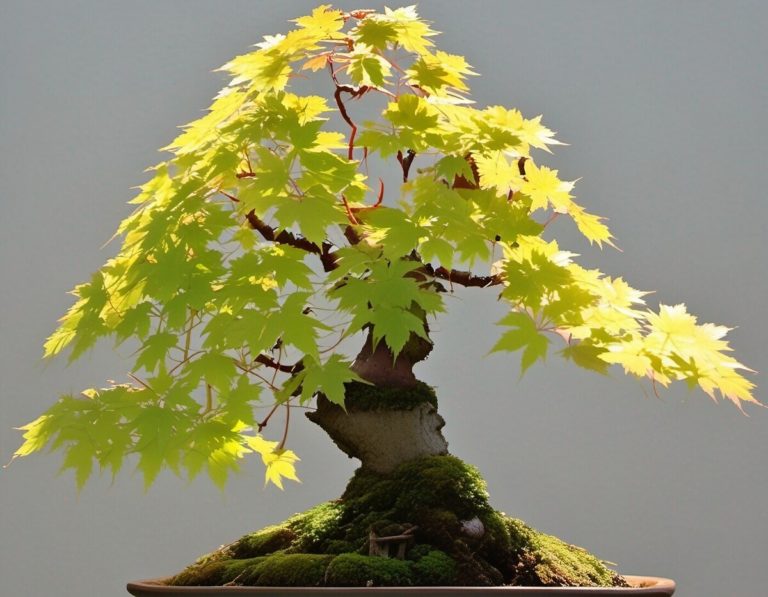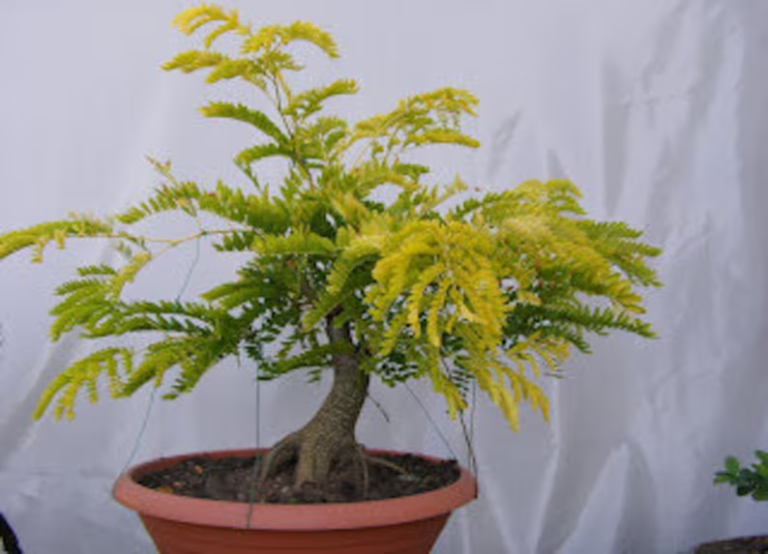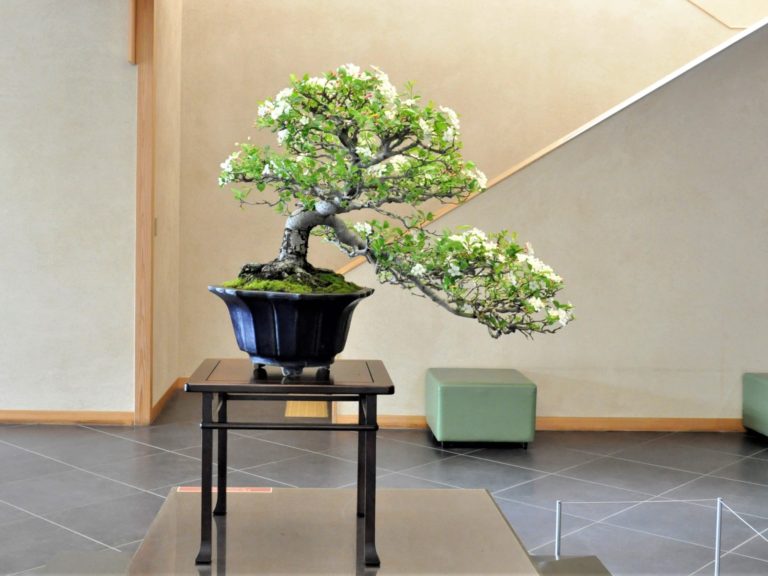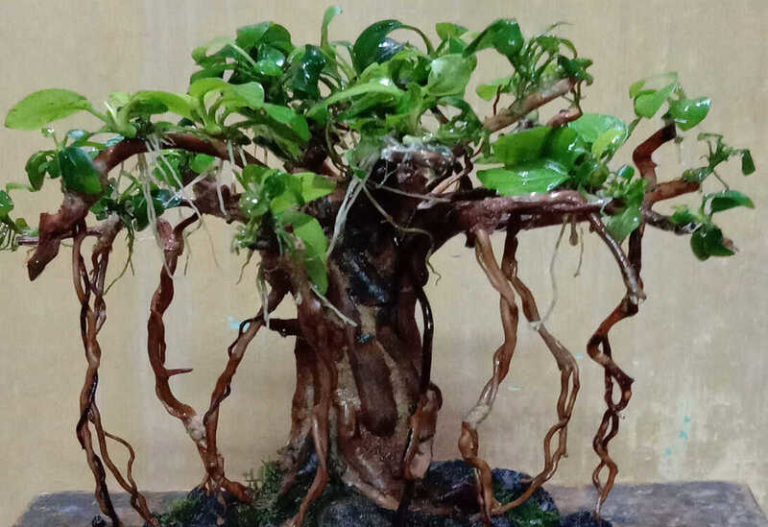Bonsai Orange Tree : Miniature Beauty and Citrus Charm
Bonsai orange trees are tiny works of art that bring the beauty of citrus into your home in a form that is easy to care for. Growing these little trees is more than just a hobby; it’s an art form that pays off. We’ll show you the steps, tools, and care you need to take care of your own Bonsai orange tree, even if you’ve never done it before.
What is a Bonsai Orange Tree
A Bonsai Orange Tree is a small, cultivated version of an orange tree, created through careful pruning and shaping techniques. It has the look of a full-grown orange tree, but it is much smaller. Bonsai fans use special techniques to keep the trees small while keeping their natural beauty.
History and Origins of the Bonsai Orange Tree
Bonsai has been around for more than a thousand years, and Bonsai Orange Trees have been grown for that long. Bonsai is an art form that started in China and was later taken up and improved by the Japanese.
Ancient China: In ancient China, tiny landscapes and trees were grown in pots in ways that were similar to bonsai. These early styles of bonsai paved the way for the art we know today.
Bonsai in Japan: Japan got bonsai at some point, most likely during the Tang Dynasty (618–907 AD). The Japanese loved bonsai and made it their own by adding their own methods and styles. Over many years, Japan became the center of growing and perfecting bonsai.
By the time of Kamakura (1185–1333), the Japanese had created their own unique types of bonsai. Japanese culture had a big impact on the art form because it values balance, harmony, and simplicity. The upper class grew bonsai as a sign of their wealth and status.
Bonsai Orange Trees: People who practice bonsai used to only work with local trees, but over time, they started to try growing fruit trees like oranges. Bonsai Orange Trees became more famous as a unique and beautiful addition to bonsai collections.
Modern Era: In the 20th century, bonsai, like Bonsai Orange Trees, became popular all over the world. The broad bonsai community we see today came about when bonsai fans all over the world accepted different styles, techniques, and species.
Today, Bonsai Orange Trees show how the art form of bonsai has changed and grown over time. Growers keep improving their methods to make sure that these tiny orange trees keep their beauty and artistic value in the world of bonsai.
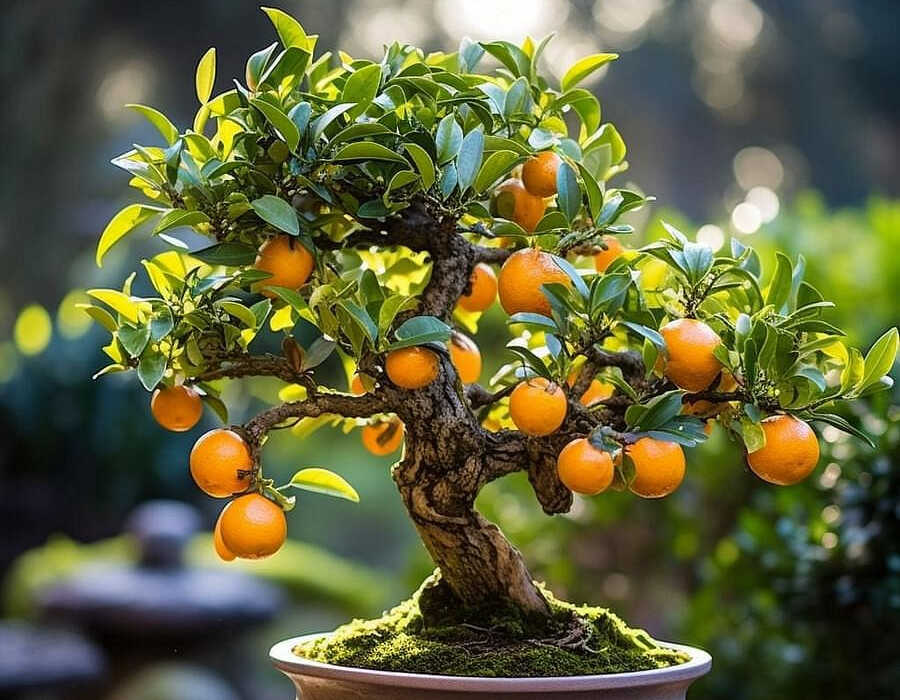
Bonsai Orange Tree and Their Symbolism
Like other bonsai plants, orange trees have deep meanings that come from their old roots. These little orange trees stand for the following:
1. Patience and Perseverance:
To grow bonsai, you need to be patient and dedicated. The careful and slow shape of a Bonsai Orange Tree is a metaphor for being patient and persistent. Fans are reminded that beautiful things take time to grow and develop, which teaches them how important it is to keep going even when things get hard.
2. Harmony and Balance:
Bonsai, like Bonsai Orange Trees, show how nature and human activity can work together in harmony. The skillful balance between creating the tree and letting it grow freely is a sign of peace between people and nature. This balance shows how to live in harmony with nature and shows how important it is to keep things in balance in life.
3. Beauty in Simplicity:
The simple but beautiful look of bonsai orange trees represents the beauty that can be found in things that are simple. When you practice bonsai, you learn how to be minimalist and find beauty in the simplest shapes. People who read it are told to enjoy the little things in life and be happy with what they have.
4. Reflection of Nature:
As a whole, bonsai is like a small form of nature. In particular, bonsai orange trees bring the life and energy of fruit trees into a small package. They represent the most beautiful parts of nature and make us think of the bigger natural world, even when they’re only in a small pot.
5. Cultural and Spiritual Significance:
People in some countries think that bonsai trees, like Bonsai Orange Trees, bring happiness, wealth, and good energy. They are often linked to peace and are used in meditation to help people feel calm and at peace with themselves.
6. Appreciation for Age and Wisdom:
Even though they are small, bonsai trees, like Bonsai Orange Trees, often look old and wise. This meaning shows respect for older people and the knowledge that comes with getting older. As a lesson, we should respect the people who came before us and learn from their stories.
Bonsai orange trees stand for patience, peace, simplicity, nature, cultural importance, and respecting old age and knowledge. Many people enjoy growing and admiring these tiny orange trees because they look nice, but they also teach people important lessons about life and hold cultural significance.
How to Grow Bonsai Orange Tree
Growing a Bonsai Orange Tree can be a rewarding and meditative experience. Here’s a step-by-step guide to help you get started:
1. Choose the Right Orange Tree Variety:
Select a citrus variety suitable for bonsai, such as Calamondin (Citrus microcarpa) or Kumquat (Fortunella). These varieties are smaller in size and adapt well to bonsai cultivation.
2. Select the Right Container:
Choose a shallow and wide pot with drainage holes. The pot should be large enough to accommodate the roots but not excessively large to maintain the tree’s miniature size.
3. Prepare the Potting Mix:
Use well-draining soil, preferably a mix of akadama, pumice, and lava rock. This mix ensures good aeration and water drainage, essential for bonsai growth.
4. Planting the Bonsai Tree:
- Carefully remove the tree from its nursery pot, ensuring not to disturb the roots excessively.
- Trim any long or damaged roots.
- Place a layer of soil in the bottom of the bonsai pot and position the tree on it.
- Fill the remaining space with the prepared potting mix, gently pressing down to remove air pockets.
5. Pruning and Shaping:
- Prune excess branches and leaves, promoting a balanced and natural appearance.
- Use sharp and clean bonsai scissors to make precise cuts. Pruning helps shape the tree and maintain its miniature size.
6. Wiring and Shaping:
- Use soft aluminum wire to gently guide branches into desired shapes. Avoid wrapping the wire too tightly to prevent damage.
- Regularly check the wiring to ensure it does not cut into the bark as the tree grows.
7. Watering and Feeding:
- Water the bonsai thoroughly when the topsoil feels slightly dry. Ensure the water drains out of the pot to prevent waterlogging.
- Fertilize the tree during the growing season (spring and summer) with a balanced liquid fertilizer, following the recommended dosage on the package.
8. Sunlight and Temperature:
- Place the bonsai orange tree where it receives plenty of sunlight, preferably 6-8 hours of indirect sunlight daily.
- Protect the tree from extreme cold temperatures, especially during winter, as citrus trees are sensitive to frost.
9. Regular Maintenance:
- Monitor the tree regularly for pests, such as aphids or spider mites. Treat any infestations promptly.
- Repot the bonsai every 2-3 years, refreshing the soil and pruning the roots slightly to encourage new growth.
10. Patience and Observation:
Bonsai trees, including Bonsai Orange Trees, require time and patience to develop their desired shape and aesthetics. Observe the tree’s growth patterns and adjust your care techniques accordingly.
Remember, growing a Bonsai Orange Tree is a long-term commitment that requires dedication and attention. With proper care and patience, you can cultivate a beautiful and harmonious miniature orange tree to adorn your living space.
Displaying and Showcasing the Bonsai Orange Tree
Displaying and showcasing your Bonsai Orange Tree is an art in itself, enhancing the tree’s beauty while complementing your living space. Here are some creative ideas to display your Bonsai Orange Tree effectively:
1. Choose the Right Stand or Table:
Choose a stand or table that is strong, looks good, and goes with the style of your Bonsai Orange Tree. Think about stands made of wood, pottery, or metal that will make the tree look better.
2. Select a Suitable Pot:
Pick a pretty bonsai pot that goes with the style and color of the tree. With the green leaves and orange flowers, traditional earthy tones or bright colors can make a striking difference.
3. Use Accent Elements:
Add small decorative stones, moss, or tiny figures as accents to make the display look better. These things give the space a charming touch and make it look more natural.
4. Proper Lighting:
Put your Bonsai Orange Tree somewhere bright to make it look its best. For most bonsai trees, natural sunshine that comes from the side is best. You can also use LED lights that can be adjusted to get the best lighting.
5. Rotate the Tree:
To make sure the bonsai grows evenly, turn it every so often. This keeps the tree from bending in one direction and makes sure that all of its sides get enough sunlight.
6. Seasonal Changes:
Accept that the seasons are changing by using seasonal features. For instance, in the spring, put small flowers or plants that flower around the base. Use bright leaves or small pumpkins in the fall to make the room feel like the season.
7. Grouping Bonsai Trees:
Putting your bonsai trees together in a group might make them look better if you have more than one. Change the styles and heights to make a balanced arrangement.
8. Regular Maintenance:
Make sure the show area is neat and clean. To keep the tree’s shape, cut back any stems or leaves that are getting too big. Regularly clean out the pot of dead leaves and other junk.
9. Showcasing During Bonsai Exhibitions:
When you show off your bonsai, pay attention to how the whole thing is put together. To make a nice show, use the right display tables, accent pieces, and backgrounds. Make sure there is enough light to show off the tree’s traits.
10. Share Your Passion:
Tell your family and friends about your bonsai orange tree and how to take care of it. Your excitement will make the tree more meaningful and make it an interesting topic of discussion.
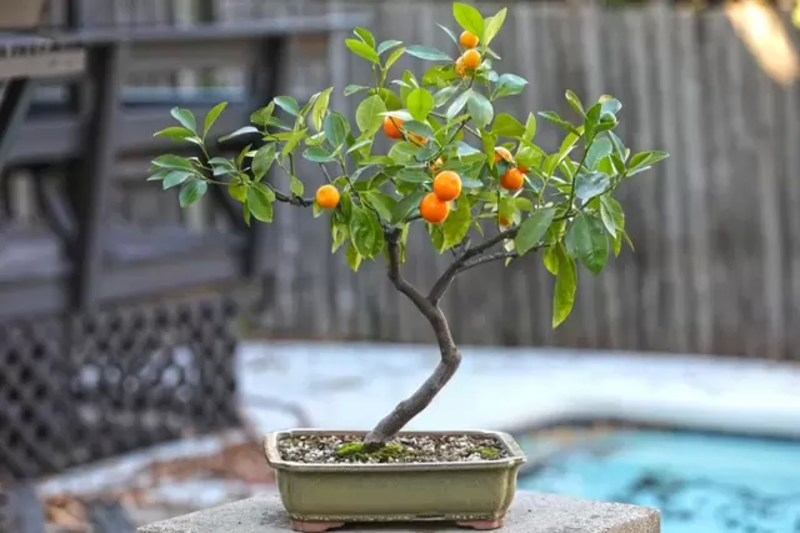
Remember that the way you show off your Bonsai Orange Tree shows how creative you are and how much you value this old art form. Play around with different arrangements and elements to make a beautiful display that shows off the beauty of your tiny orange tree.
How to Care for and Maintain a Bonsai Orange Tree
Caring for a Bonsai Orange Tree requires attention to detail and consistent care. Here’s a comprehensive guide to help you maintain your tree’s health and beauty:
1. Watering:
- Frequency: Water your Bonsai Orange Tree thoroughly when the topsoil feels slightly dry. The frequency of watering depends on factors like climate, pot size, and tree age. Check the soil moisture regularly.
- Watering Technique: Water the tree gently and evenly, ensuring water reaches all parts of the root system. Use a watering can with a fine nozzle to avoid disturbing the soil.
2. Lighting:
- Sunlight: Bonsai Orange Trees need plenty of sunlight, preferably 6-8 hours of indirect sunlight daily. Place your tree near a window where it can receive bright, filtered light.
- Seasonal Adjustments: During hot summers, protect the tree from intense afternoon sunlight. In winter, ensure the tree still receives adequate light, possibly by using artificial grow lights.
3. Temperature and Humidity:
- Temperature: Bonsai Orange Trees thrive in warm climates. Protect them from frost and extreme cold temperatures. They can be placed outdoors in warm months but should be brought inside during winter in colder regions.
- Humidity: Citrus trees prefer higher humidity. Mist the tree regularly, especially if you live in a dry climate. You can also place the pot on a tray filled with water and pebbles to increase humidity around the tree.
4. Pruning and Shaping:
- Regular Pruning: Prune the tree regularly to maintain its shape. Remove dead or unhealthy branches and trim excess growth. Use sharp and clean bonsai scissors or pruning shears for precise cuts.
- Pinching: Pinch off new growth with your fingers to encourage branching and create a denser foliage canopy.
5. Fertilization:
- Fertilizer Type: Use a balanced liquid fertilizer specifically designed for citrus plants. Fertilize your Bonsai Orange Tree during the growing season (spring and summer) every 2-4 weeks.
- Application: Dilute the fertilizer to half the recommended strength and apply it when the soil is moist. Avoid fertilizing during winter when the tree is in a dormant state.
6. Repotting:
- Timing: Repot your Bonsai Orange Tree every 2-3 years, usually in spring when the tree is entering a period of active growth.
- Root Pruning: Trim the roots slightly to encourage new growth. Use well-draining soil during repotting.
7. Pest and Disease Control:
- Vigilance: Regularly inspect your tree for signs of pests like aphids, spider mites, or scale insects. Treat infestations promptly with insecticidal soap or neem oil.
- Preventive Measures: Keep your tree clean, well-ventilated, and avoid overwatering to prevent common bonsai pests and diseases.
8. Training and Wiring:
- Wiring: Use soft aluminum wire to gently shape branches. Check the wiring regularly to prevent it from cutting into the bark. Remove the wire once the branch has set in the desired shape.
- Training: Train your Bonsai Orange Tree by guiding its growth with strategic pruning and wiring. Patience is essential; shaping a bonsai takes time and gradual adjustments.
9. Protection from Wind and Drafts:
- Wind Protection: Shield your Bonsai Orange Tree from strong winds, which can dry out the foliage and stress the tree.
- Avoid Drafts: Avoid placing the tree near drafts from windows, air conditioners, or heaters, as rapid temperature changes can harm the tree.
10. Regular Observation and Adjustment:
- Observation: Observe your tree closely. Notice how it responds to different conditions, including changes in light, temperature, and watering. Adjust your care routine accordingly to address the tree’s needs.
Remember, each Bonsai Orange Tree is unique, and its care requirements might vary based on its specific environment and individual characteristics. Regular attention, patience, and a watchful eye will help you maintain a healthy and thriving Bonsai Orange Tree that brings natural beauty into your living space.

Bonsai Orange Tree Care Sheet Table
| Aspect | Care Tips |
|---|---|
| Watering | – Water the tree when the top 1-2 inches of soil are dry, typically every 5-10 days in summer, less in winter. Avoid overwatering. Use a well-draining soil mix. |
| Sunlight | – Place the tree in a sunny location with at least 6 hours of direct sunlight daily. Protect it from harsh midday sun in hot climates. Use artificial lighting if necessary in low-light conditions. |
| Temperature | – Maintain temperatures between 55-85°F (13-29°C). Protect the tree from extreme cold; bring it indoors if necessary during frost or cold spells. |
| Humidity | – Bonsai Orange Trees benefit from higher humidity. Use a humidity tray, humidifier, or mist the tree regularly to maintain humidity levels. |
| Fertilization | – Fertilize every 4-6 weeks during the growing season (spring to early autumn) with a balanced liquid fertilizer. Reduce feeding in late autumn and winter. |
| Pruning and Trimming | – Regularly prune to shape the tree, removing dead or crossing branches. Pinch back new growth to encourage branching and maintain shape. |
| Wiring and Styling | – Wire branches carefully to shape the tree. Use soft aluminum wire and check regularly to prevent wire cutting into the branches. Styling can be done in spring and early summer. |
| Repotting | – Repot every 2-3 years in early spring. Choose a well-draining bonsai soil mix. Trim roots and prune branches during repotting to maintain the desired size and shape. |
| Pest and Disease Control | – Keep a lookout for pests like aphids, mealybugs, and scale insects. Treat with neem oil or insecticidal soap. Monitor for diseases like root rot and address promptly. |
| Winter Care | – In cold climates, move the tree indoors or provide protection from freezing temperatures. Water sparingly during winter to prevent root rot. |
| Regular Maintenance | – Continuously monitor the tree for its overall health. Regularly check for any signs of stress, like wilting leaves, and address issues promptly. Maintain the tree’s desired shape through pruning and training. |
Keep in mind that every Bonsai Orange Tree may have different care needs. Change how you care for your trees based on what they need and how they respond to your care. For bonsai to do well, they need to be watched and adjusted on a regular basis.
Conclusion
A bonsai orange tree is a fun project that teaches you how to be patient and take care of something. You can start your own Bonsai adventure now that you have this easy plan. So, get your hands dirty and take care of your tree. Soon, it will grow into a beautiful little orange garden right in your own house. Good luck with your bonsai!
FAQ
1. Can I grow an orange tree as a bonsai?
- Yes, you can grow an orange tree as a bonsai. Bonsai orange trees are popular among bonsai enthusiasts and can be cultivated in containers to maintain their small size and unique shape.
2. What type of orange tree is suitable for bonsai?
- Dwarf or miniature varieties of orange trees are ideal for bonsai, such as Calamondin (Citrus microcarpa) or Kumquat (Fortunella spp.). These varieties have naturally small leaves and fruits, making them well-suited for bonsai cultivation.
3. How do I care for a bonsai orange tree?
- Bonsai orange tree care involves proper watering, adequate sunlight, regular pruning and shaping, repotting as needed, and attention to temperature and humidity requirements. Refer to the care sheet provided earlier for detailed care instructions.
4. Can I grow a bonsai orange tree indoors?
- Yes, you can grow a bonsai orange tree indoors, especially in regions with harsh winters. Place the tree near a sunny window or use artificial lighting to provide adequate sunlight. Ensure proper humidity levels and temperature control.
5. When should I repot my bonsai orange tree?
- Repot your bonsai orange tree every 2-3 years in early spring, just before the growing season begins. During repotting, trim the roots and prune the branches to maintain the desired size and shape.
6. Can I grow bonsai orange trees from seeds or cuttings?
- While it is possible to grow bonsai orange trees from seeds or cuttings, it can be a slower process. Many bonsai enthusiasts prefer to start with young trees or purchase pre-bonsai specimens to save time.
7. What pests and diseases should I watch out for with bonsai orange trees?
- Common pests include aphids, mealybugs, and scale insects. Keep an eye out for these and treat with neem oil or insecticidal soap as needed. Also, monitor for diseases like root rot and address them promptly.
8. How do I shape my bonsai orange tree through pruning and wiring?
- Regularly prune to maintain the desired shape and remove any dead or crossing branches. You can also use wiring to guide branches into the desired positions. Wiring should be done with care and checked regularly to prevent damage.
9. Can I enjoy fruit from my bonsai orange tree?
- Bonsai orange trees can produce small fruits, but the primary focus is on aesthetics and not fruit production. The fruit may be edible, but it is often not as flavorful or abundant as that from standard orange trees.
10. What are some common mistakes to avoid when caring for a bonsai orange tree? –
- Common mistakes include overwatering, insufficient sunlight, using the wrong soil mix, neglecting pruning and shaping, and ignoring signs of stress or pests. Regular observation and adjustment are essential for successful bonsai care.
Also Read:



